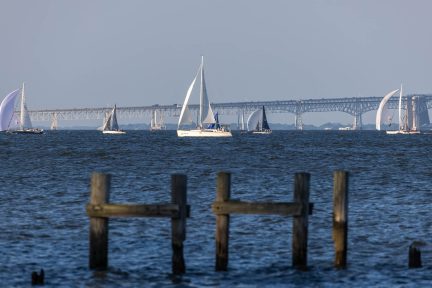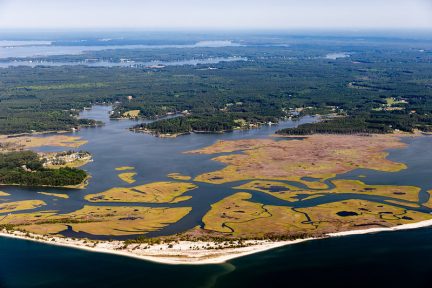Slightly smaller-than-average dead zone predicted for Chesapeake Bay
Slightly smaller-than-average dead zone predicted for Chesapeake Bay
Researchers from the Chesapeake Bay Program, the University of Maryland Center for Environmental Science, University of Michigan and U.S. Geological Survey announced today that they are forecasting a slightly smaller than average Chesapeake Bay “dead zone” this year, due to reduced rainfall and less nutrient-rich runoff flowing into the Bay from the watershed this spring.
Hypoxic and anoxic regions, areas of low and no oxygen, respectively, are caused by excess nutrient pollution flowing into the Bay. Compared to the past 34 years, this year’s Chesapeake Bay hypoxic volume, or “dead zone”, is expected to be nine percent lower than average, while the volume of water with no oxygen is predicted to be four percent lower than average. The predicted volumes are smaller than the dead zone in 2019, a year with exceptionally high freshwater flows and nutrient pollutants entering the Bay.
Although different types of nutrients contribute to the annual dead zone, it is the amount of nitrogen that enters the Bay from January-May that is a key driver in how hypoxic conditions can vary from year-to-year. In spring 2020, the Bay received a slightly below-average amount of nitrogen pollution (17%) compared to the long-term average. Overall, nitrogen loads entering the Bay included 111 million pounds recorded at nine river input monitoring stations and 7.3 million pounds from treated wastewater.
Throughout the year, researchers measure oxygen and nutrient levels as part of the Chesapeake Bay Monitoring Program, a Bay-wide cooperative effort involving watershed jurisdictions, several federal agencies, 10 academic institutions and over 30 scientists. Among these institutions, the Maryland Department of Natural Resources and Virginia Department of Environmental Quality conduct 8-10 cruises between May – October, depending on weather conditions, to track summer hypoxia in the Bay. Results from each monitoring cruise can be accessed through the Eyes on the Bay website for the Maryland portion of the Bay and the VECOS website for the Virginia portion. Estimates of river flow and nutrients entering the Bay can be accessed on the U.S. Geological Survey’s website. A Bay-wide assessment of the 2020 dead zone will be available this fall.
Facts
Since 2007, a model developed by the University of Michigan has been used to forecast the volume of summer hypoxia for the mainstem of the Chesapeake Bay by using the amount of nitrogen pollution flowing into the Bay from the Susquehanna River from the previous January-May. A companion model from the University of Maryland Center for Environmental Science forecasts summer volumes of oxygen-free water. Each of these models and forecasts are supported by the most up-to-date river flow and nutrient inputs from the U.S. Geological Survey. Scientists at the Virginia Institute of Marine Science, in collaboration with Anchor QEA, produce daily real-time estimates of hypoxia volume that are already showing substantially less hypoxia for 2020 than in recent years. Funding for the models has come from the National Oceanic and Atmospheric Administration and data used by the models are provided by the U.S. Geological Survey, Maryland Department of Natural Resources, Virginia Department of Environmental Quality and Chesapeake Bay Program.
In 2020, the hypoxia forecast model was updated, refined and later transferred to the Chesapeake Bay Program through a collaborative effort led by modelers at the University of Michigan, University of Maryland Center for Environmental Science, Virginia Institute of Marine Science, U.S. Geological Survey and Chesapeake Bay Program. The enhanced model now allows for hypoxia projections for an average July, average summer and the total annual hypoxia volume, based on the measure of nitrogen pollution and river flow that is captured at the nine river input monitoring stations by the U.S. Geological Survey, through partnerships with Maryland and Virginia. Together, these stations—which are located on the Appomattox, Choptank, James, Mattaponi, Pamunkey, Patuxent, Potomac, Rappahannock and Susquehanna rivers—reflect nitrogen loads, as well as other important nutrients, flowing into the Bay from 78 percent of its 64,000-square-mile watershed.
Issues
The dead zone is an area of little to no oxygen that forms when excess nutrients, including both nitrogen and phosphorus, enter the water through polluted runoff and feed naturally-occurring algae. This drives the growth of algae blooms, which eventually die and decompose, removing oxygen from the surrounding waters faster than it can be replenished. This creates low-oxygen—or hypoxic—conditions. Plant and animal life are often unable to survive in this environment, which is why the area is sometimes referred to as a “dead zone”.
Pollution reducing practices used in backyards, cities and on farms can reduce the flow of nutrients into waterways. Management actions taken to decrease loads from point sources (e.g. wastewater treatment plants) may immediately show detectable pollution changes, but regarding the implementation of best management practices for non-point sources, there is often a lag in measuring their impact on improving water quality and the health of the Bay.
Weather conditions also play a role in the size and duration of the annual dead zone. Heavy rainfall can lead to strong river flows entering the Bay, which carries along increased amounts of nutrient pollution. Above average spring freshwater flows to the Bay, along with hot temperatures and weak winds provide the ideal conditions for the dead zone to grow larger and last longer, as occurred in 2019.
Quotes
“The river flows and nutrient loads were closer to average conditions in spring 2020. The more normal spring flows, along with the nutrient reduction efforts of the Chesapeake Bay Program, should result in smaller amounts of hypoxia this summer compared to 2018 and 2019, when near-record levels of spring rains washed more nutrients into the Bay.”
- Scott Phillips, Co-Chair, Scientific Technical Assessment and Reporting Workgroup, Chesapeake Bay Program
"The hypoxic forecast is a critical component to tracking progress of our Chesapeake Bay restoration efforts. Dissolved oxygen levels are a key indicator of Bay health as sufficient oxygen is needed to support our iconic Chesapeake species such as oysters, crabs and fin fish. The forecast brings attention to our continued need to implement our nutrient reduction strategies. We look forward to working with our Bay Program partners to monitor and report on hypoxic levels throughout the summer."
- Bruce Michael, Director of Resource Assessment Service, Maryland Department of Natural Resources
"The forecasts continue to help scientists understand what controls long-term changes in hypoxia in Chesapeake Bay, improving our ability to predict them and to identify actions to mitigate them. "
- Jeremy Testa, Associate Professor, Chesapeake Biological Laboratory, University of Maryland Center for Environmental Science
"We are excited to see our research forecast model transferred into operations at the Chesapeake Bay Program, ensuring its continuity, updates, and refinements. "
- Donald Scavia, Professor Emeritus, School for Environment and Sustainability, University of Michigan
"These forecasts are very interesting for comparing to real-time estimates of hypoxia throughout the summer, to see how short-term weather affects the amount of hypoxia relative to the largest driver of hypoxia, nutrient inputs to the Bay. "
- Aaron Bever, Managing Scientist, Anchor QEA



